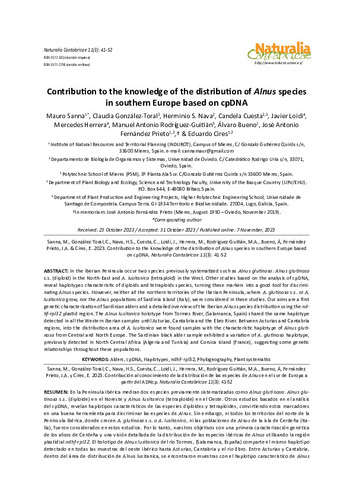Contribution to the knowledge of the distribution of Alnus species in southern Europe based on cpDNA
Palabra(s) clave:
Alders
cpDNA
Haplotypes
ndhF-rpl32
Phylogeography
Plant systematics
Fecha de publicación:
Citación:
Descripción física:
Resumen:
In the Iberian Peninsula occur two species previously systematized such as Alnus glutinosa: Alnus glutinosa s.s. (diploid) in the North-East and A. lusitanica (tetraploid) in the West. Other studies based on the analysis of cpDNA, reveal haplotypes characteristic of diploids and tetraploids species, turning these markers into a good tool for discriminating Alnus species. However, neither all the northern territories of the Iberian Peninsula, where A. glutinosa s.s. or A. lusitanica grow, nor the Alnus populations of Sardinia Island (Italy), were considered in these studies. Our aims are a first genetic characterization of Sardinian alders and a detailed overview of the Iberian Alnus species distribution using the ndhf- rpl32 plastid region. The Alnus lusitanica holotype from Tormes River, (Salamanca, Spain) shared the same haplotype detected in all the Western Iberian samples until Asturias, Cantabria and the Ebro River. Between Asturias and Cantabria regions, into the distribution area of A. lusitanica were found samples with the characteristic haplotype of Alnus glutinosa from Central and North Europe. The Sardinian black alder sample exhibited a variation of A. glutinosa haplotype, previously detected in North Central Africa (Algeria and Tunisia) and Corsica island (France), suggesting some genetic relationships throughout these populations.
In the Iberian Peninsula occur two species previously systematized such as Alnus glutinosa: Alnus glutinosa s.s. (diploid) in the North-East and A. lusitanica (tetraploid) in the West. Other studies based on the analysis of cpDNA, reveal haplotypes characteristic of diploids and tetraploids species, turning these markers into a good tool for discriminating Alnus species. However, neither all the northern territories of the Iberian Peninsula, where A. glutinosa s.s. or A. lusitanica grow, nor the Alnus populations of Sardinia Island (Italy), were considered in these studies. Our aims are a first genetic characterization of Sardinian alders and a detailed overview of the Iberian Alnus species distribution using the ndhf- rpl32 plastid region. The Alnus lusitanica holotype from Tormes River, (Salamanca, Spain) shared the same haplotype detected in all the Western Iberian samples until Asturias, Cantabria and the Ebro River. Between Asturias and Cantabria regions, into the distribution area of A. lusitanica were found samples with the characteristic haplotype of Alnus glutinosa from Central and North Europe. The Sardinian black alder sample exhibited a variation of A. glutinosa haplotype, previously detected in North Central Africa (Algeria and Tunisia) and Corsica island (France), suggesting some genetic relationships throughout these populations.
Patrocinado por:
This study was was partially supported by the research program (PAPI-19-GR-2016-0010) funded by the University of Oviedo.
Colecciones
- Artículos [37549]
- Biología Funcional [807]
- Indurot [171]
- Investigaciones y Documentos OpenAIRE [8420]
Ficheros en el ítem




